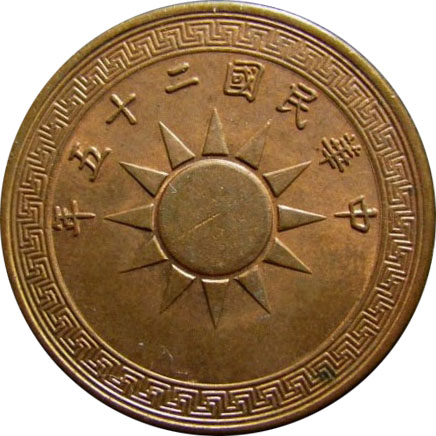
 |
During China's chaotic history, there has been a genuine attempt to issue a universal coinage for all of China. At the Western front, Chinese Communism took over in 1927 to 1936. At the Eastern front, Japan was busy occupying parts of China - Manchukuo, East Hopei from 1933 onwards. As the civil war prolonged and the Japanese carving parts of China, various challenges were presented. More information about the history of Republic of China can be read here - it's quite a bit of a read... https://en.wikipedia.org/wiki/History_of_the_Republic_of_China |
| In 1936, China managed to issue a universal circulating fraction coinage based in pure nickel. Dies were prepared in Philadelphia, US. The spade coin is based on an ancient 'pu' coin that circulated in Shantung Province. Coins were struck in Shanghai initially. A small batch was struck in Tienstin and it is assumed that it only struck 1 million of 10 fen coins. This can only be determined by its non magnetic property. Another interesting fact is that some of the first issues were contracted and struck in Austria, designed by Regierungarat Richard Placht. There are some minor differences between the American and Austrian designs. |  |
In 1937 as the Japanese got closer to Shanghai, Shanghai Mint was dismantled and shipped to various regional mints.
1) Wuchang, Hupeh Province - machineries from Shanghai added to existing plant. Exclusive to nickel and copper coins. Work supposedly commenced in November 1937 but struck coins dated 1936.
2) Kweilin, Kwangsi Province - nickel and copper coins struck from May 1938 onwards
3) Chungking, Szechuan Province - struck nickel and copper coins from August 1938
4) Lanchow, Kansu Province - Supposedly only copper coins were issued
5) Chengtu, Szechuan Province - Nickel coins struck from July 1938
6) Kunming, Yunnan Province - Early 1939 started producing nickel and copper coins. Was partially destroyed by the Japanese in October 1940
In 1940, Kweilin mint was relocated to undisclosed place in Sikong Province.
Like in any countries involved in the war, metals became expensive due to being strategic war materials. Pure nickel coins became a luxury and in 1940, the Ministry of Finance made changes of pure nickel coins to be of 18% nickel, 55% copper and 27% zinc. This immediately led the early 1936 coins to be removed from circulation and melted down. Aluminium coins were struck in Shanghai Mint on the behalf of Central Bank of China. As of where 1 and 2 fen brass coins were struck - Szechuan Province seems to be the most likely place as they had experience striking brass coins in 1910s.
Some interesting facts
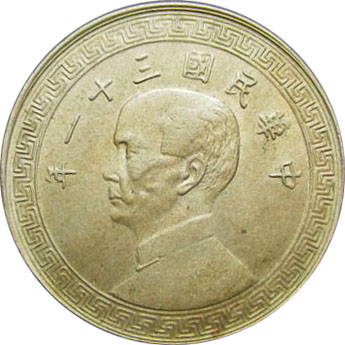
For some reason, some reference refer this portrait as Lin Sen. Lin Sen is known as the the Chairman of the Government of Republic of China from 1931 to 1943. This however does not look anything like him... Perhaps it is meant to refer to the leader of China at that time.
In 1950, an attempt was made to make a return to the gold standard. Chengtu mint used Vienna dies of 10 and 20 cents and re-engraved 1936 to 1950. The characters 10 and 20 cents were removed however the mintmark A is still somewhat visible. 1940 5 cents die were re-engraved to 1950 5 cents and the character 5 cents were removed, and replaced with 1 chien on the left hand side and pure gold on right hand side. The pattern 5, 10 and 20 cents were struck in gold in weights of 0.325g, 0.65g, 1.3g respectively. The trial was abandoned due to the economic situation.
Most of the information is based off Eduard Kann's Illustrated catalog of Chinese coins. Sadly his book only covers nickel and aluminium coinage. If anyone else knows of any other catalog, please let me know! Thanks.
Reference: https://babel.hathitrust.org/cgi/pt?id=mdp.39015025952790;view=1up;seq=299
Listed are my collection of all the coins issued. Some coins seem to be rare according to catalog and there are some that I have genuine doubts about their existence. Most of these coins are very affordable with the exception of the 1936 10 fen (Tientsin version), 1943 ½ yuan and 1939 brass 1 fen Shi Kwan. 1936 Austrian 20 fen can be surprisingly difficult to find despite high mintage. Not too sure about the rest of the missing holes in my collection as I have not given my best effort to hunt them down.
Missing from collection:
1 fen: 1938, 1939
10 fen: Tientsin, 1939
½ fen
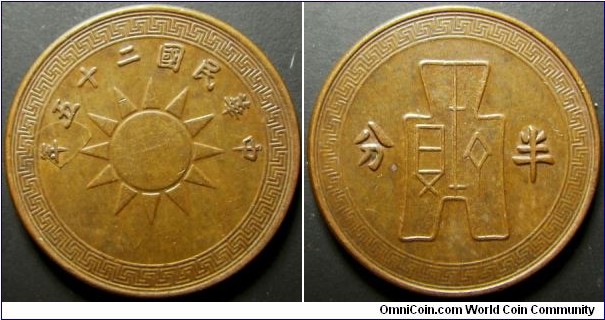 |
1936 Metal Type: Bronze Diameter (mm): 20 Weight (g): 3.5
Mintage: 64,720,000
1939 ½ fen supposedly exist but is rare |
1 fen - Copper
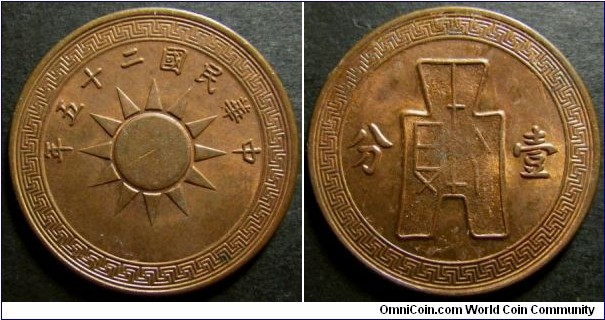 |
1936 - 1939 Metal Type: Copper Diameter (mm): 26 Weight (g): 6.7 Despite the high mintage of 1939 1 fen, survival rate is suspected to be much lower. |
| 1936 - 311,780,000 | 1937 - 307,198,000 | 1938 - 12,000,000 | 1939 - 75,000,000 |
 |
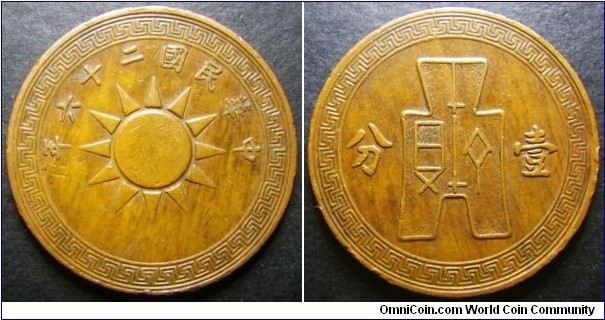 |
 |
 |
1 fen - Brass (Shi Kwan)
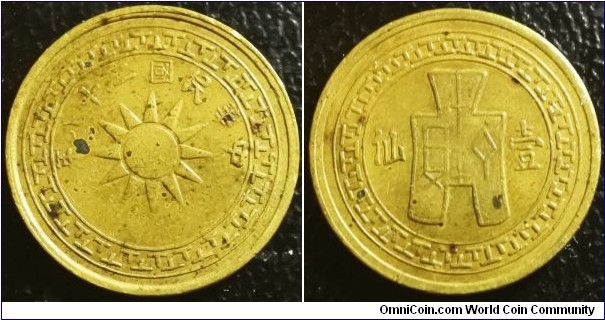 |
1939
Metal Type: Brass Diameter (mm): 20 (?) Weight (g): 3.4 (?) Mintage: ?
One year type. Somewhat scarce. Suspected to be struck in Yunnan Province. |
1 fen - Aluminium
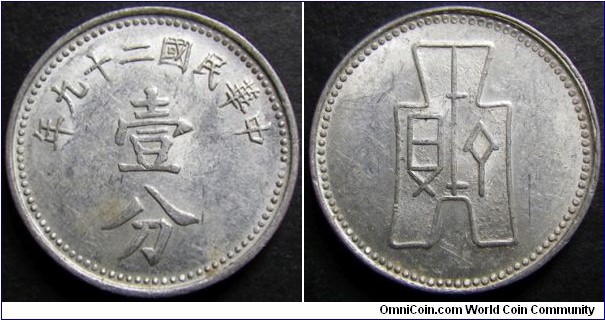 |
1940
Metal Type: Aluminium Diameter (mm): 16 Weight (g): 0.7 Mintage: 150,000,000
One year type |
1 fen - Brass
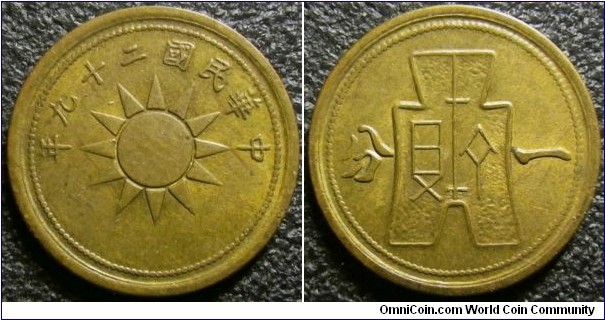 |
1940
Metal Type: Brass Diameter (mm): 15 Weight (g): 1.5(?) Mintage: 50,000,000
One year type |
1 fen - Copper (reduced size)
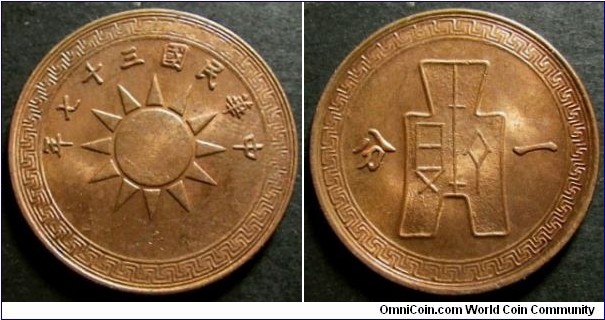 |
1948
Metal Type: Bronze Diameter (mm): 20 Weight (g): 3.5 Mintage unknown
One year type |
2 fen - Brass (Shi Kwan)
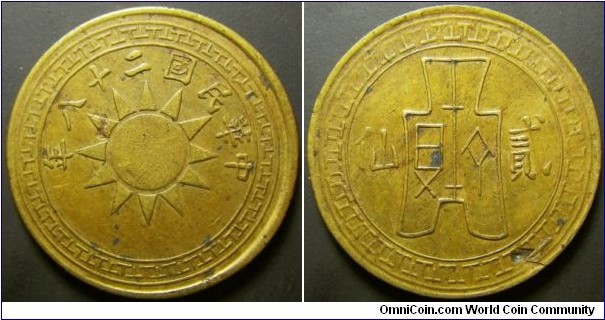 |
1939
Metal Type: Brass Diameter (mm): 26.5 Weight (g): 5.9 (?) Mintage: 300,000,000 (mintage figure possibly meant for 1940 2 fen - this is somewhat scarce)
One year type |
2 fen - Brass
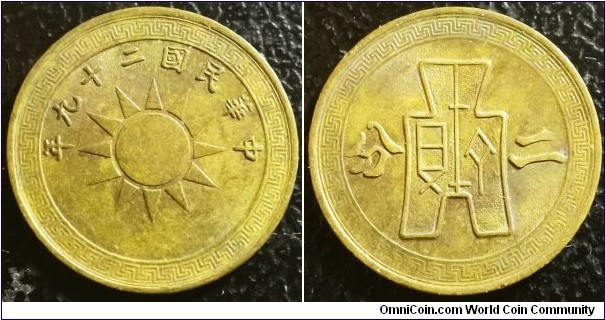 |
1940 Metal Type: Brass Diameter (mm): 19.55 Weight (g): 2.02 Mintage: unknown (Suspected to be 300 million)
One year type. 1941 2 fen exist but is extremely rare |
5 fen - Nickel
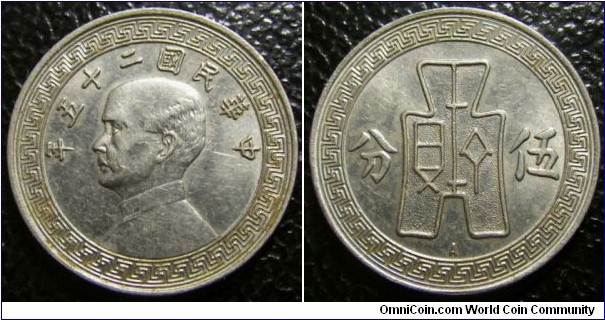 |
1936, 1938, 1939 Metal Type: Nickel Diameter (mm): 18.5 Weight (g): 3.07
3 year type. Mintmark A - Austrian Mint |
| 1936 - 72,844,000 | 1936 A - 20,000,000 | 1938 - 34,325,000 | 1939 - 6,000,000 |
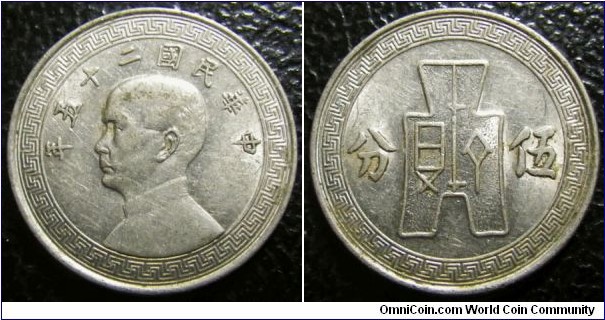 |
 |
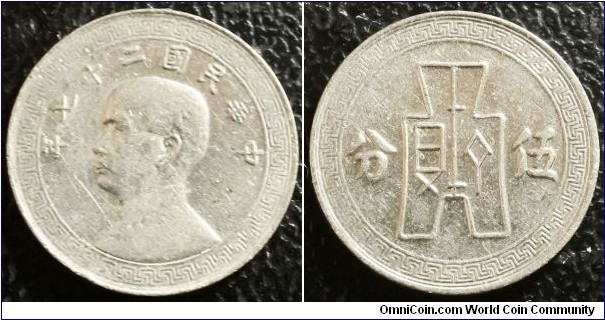 |
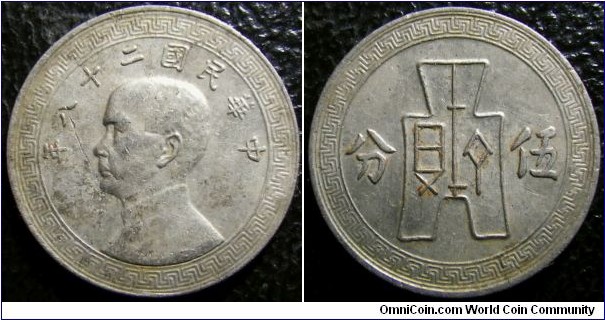 |
5 fen - Aluminium
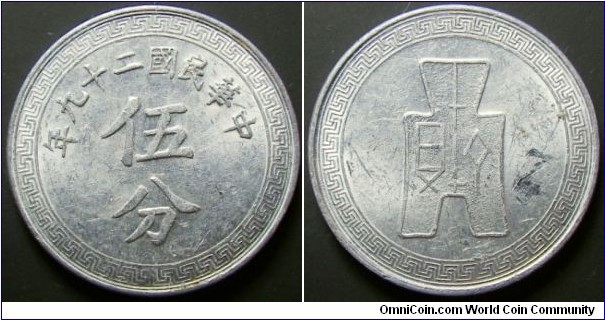 |
1940 Metal Type: Aluminium Diameter (mm): 20 Weight (g): 1.1
One year type |
5 fen - Nickel Copper
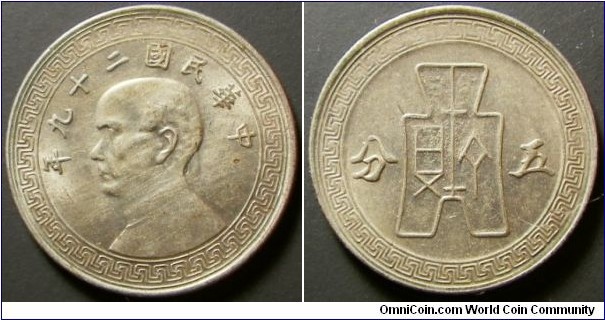 |
1940 - 1941 Metal Type: Nickel Diameter (mm): 18 Weight (g): 2.0 (?)
2 year type. |
| 1940 - 57,000,000 | 1941 - 96,000,000 |
 |
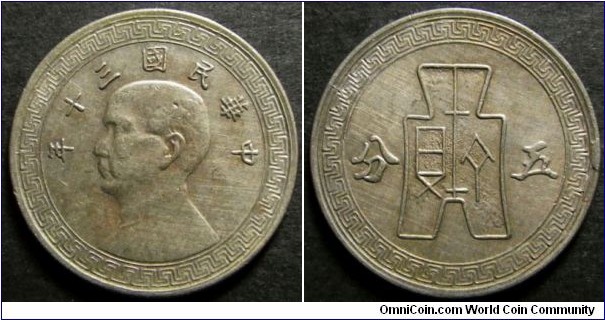 |
10 fen - Nickel
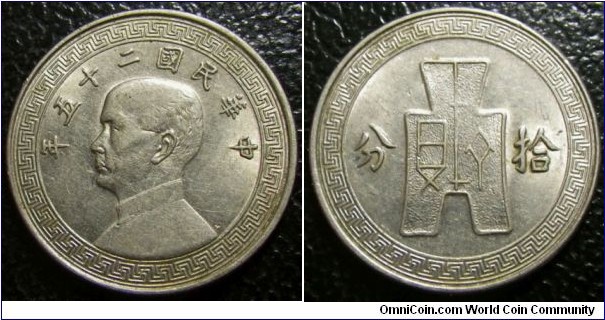 |
1936, 1938, 1939 Metal Type: Nickel Diameter (mm): 21 Weight (g): 4.5
3 year type. Mintmark A - Austrian Mint |
| 1936 - 73,866,000 | 1936 A - 60,000,000 | 1938 - 110,203,000 | 1939 - 68,000,000 |
 |
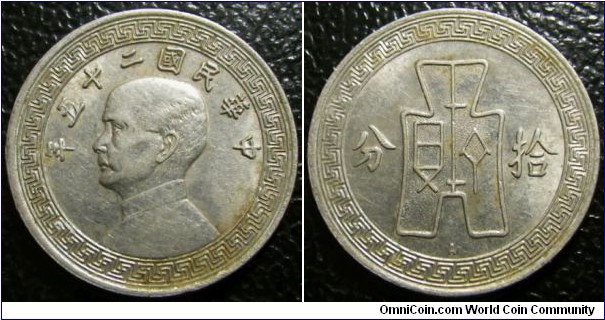 |
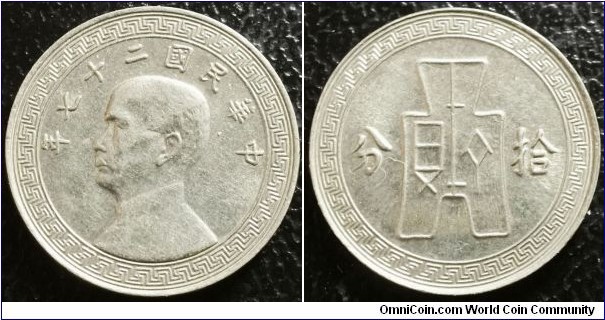 |
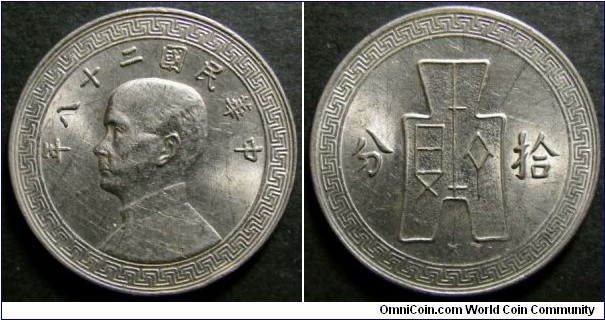 |
10 fen - Nickel alloy, non magnetic (Tientsin)
 |
1936 Metal Type: Nickel alloy Diameter (mm): 21 Weight (g): 4.5 (?)
Struck in Tientsin with same dies, supposedly by Warlord. Can only be distinguished by non magnetic property
Mintage: 1,000,000 |
10 fen - Nickel Copper
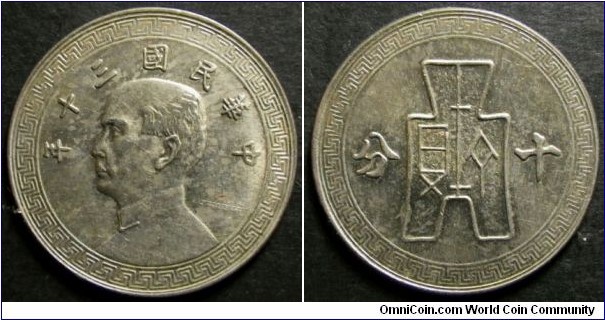 |
1940 - 1941
Metal Type: Nickel Copper Diameter (mm): 21 Weight (g): 2.84
2 year type (?). 1942 mintage reported at 10 million however not confirmed - supposedly rare. |
| 1940 - 68,000,000 | 1941 - 254,000,000 |
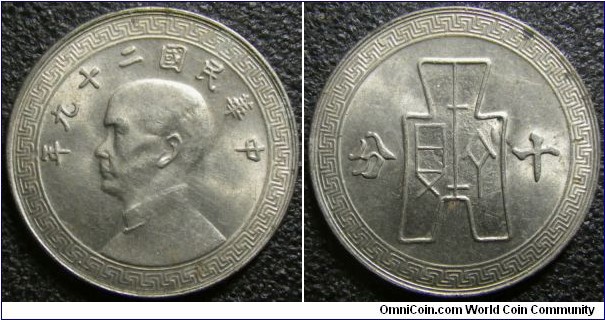 |
 |
20 fen - Nickel
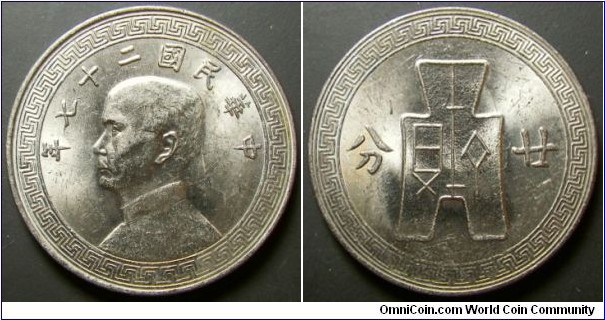 |
1936, 1938, 1939 Metal Type: Nickel Diameter (mm): 24 Weight (g): 6.05
3 year type. Mintmark A - Austrian Mint |
| 1936 - 49,620,000 | 1936 A - 40,000,000 | 1938 - 61,248,000 | 1939 - 38,000,000 |
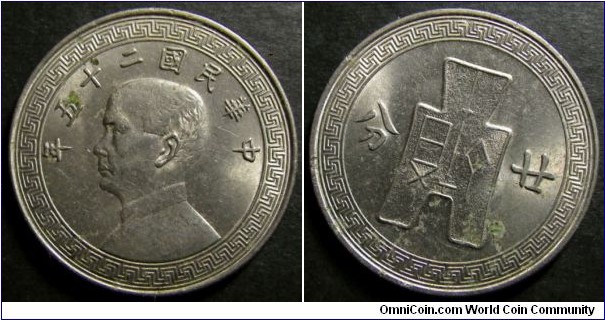 |
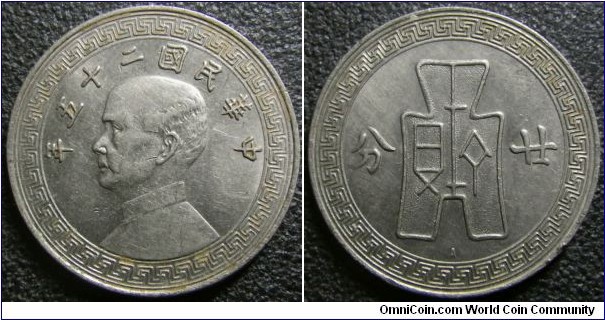 |
 |
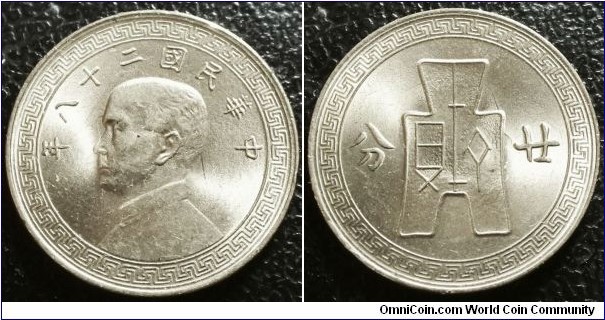 |
20 fen - Copper Nickel
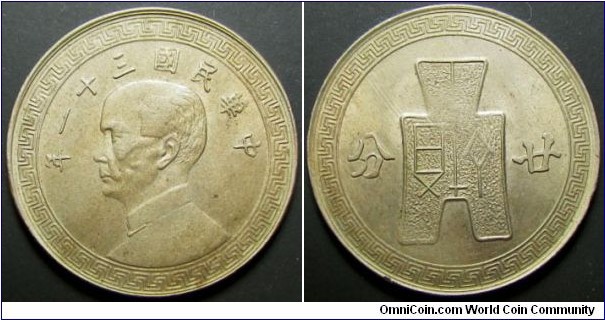 |
1942 Metal Type: Copper Nickel Diameter (mm): 24 Weight (g): 4.87
Mintage: 32,300,000
1 year type |
½ yuan
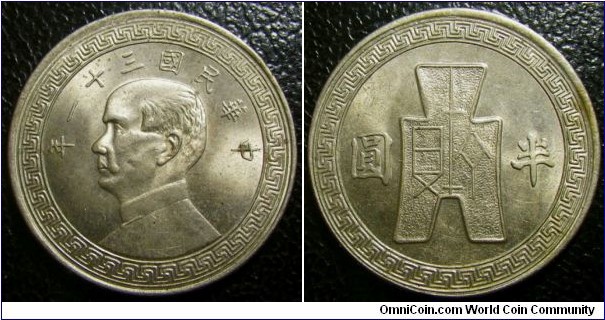 |
1942 - 1943 Metal Type: Copper Nickel Diameter (mm): 28 Weight (g): 9.06
2 year type. 1941 1/2 yuan existance is not confirmed, if not pattern. |
| 1942 - 57,000,000 | 1943 - 4,000,000 |
 |
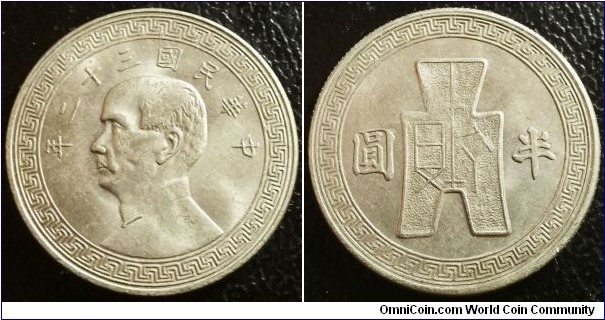 |
Last updated: 02/01/2020